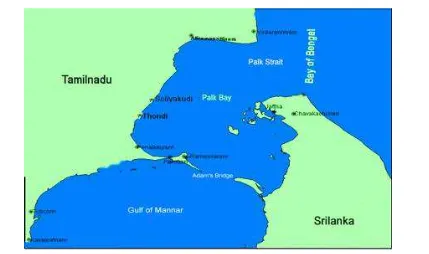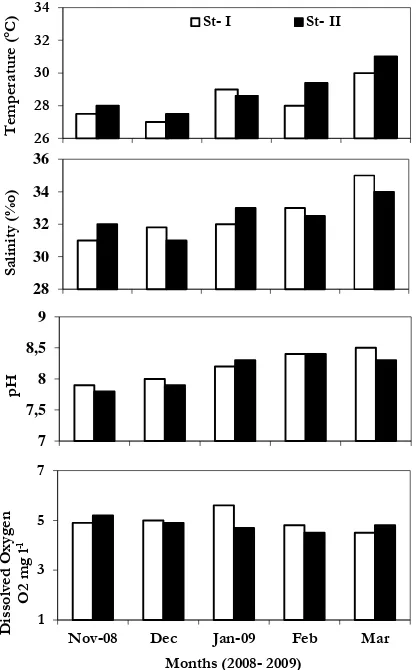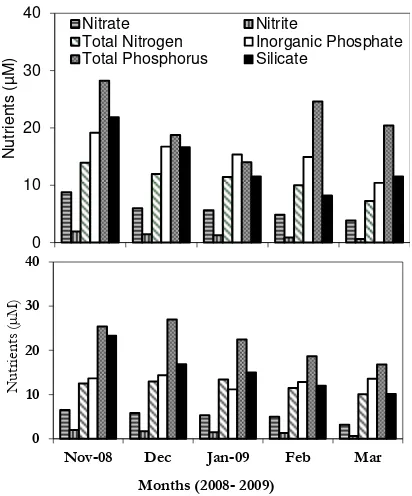[1] J.Trop.Life.Science. Vol 2. No 1. Jan, 2012 *Corresponding address:
Govindasamy. C
Department of Oceanography and Coastal Area Studies School of Marine Sciences,
Alagappa University
Thondi Campus- 623 409, Tamilnadu, India Email: govindasamyocas@gmail.com
Govindasamy. C1*, M. Arulpriya1, P. Ruban1 and V. R. Meenakshi1
1Department of Oceanography and Coastal Area Studies, School of Marine Sciences,
Alagappa University, Thondi Campus- 623 409, Tamilnadu, India
ABSTRACT
Analysis was carried out on the physico-chemical parameters measured at two stations, Thondi and Soliyakudi in the southeast Palk Strait region during the monsoon and post monsoon seasons (November 2008 – March 2009). High temperature (31˚C) and salinity (35%o) were recorded in the month of March (post monsoon). During the monsoonal season, dissolved oxygen content was found to be high (5.2 O2 mg l-1) and the total phosphorous concentration when compared to other nutrients such as NO3, NO2 and SiO2, was also high in both the stations. In general, concentrations of all the nutrients were high in Thondi during the monsoon season (November and December) which could be due to the addition of nutrients through the sewage, agricultural and land run off.
Keywords: Seasonal variation; nutrients; correlation; Palk Strait
INTRODUCTION
All known life forms on Earth depend on water and hence hydrological studies are essential to understand the relationship between its different trophic levels and food webs. The environmental conditions such as topography, water movement and stratification, salinity, oxygen, temperature and nutrients characterizing particular water mass also determine the composition of its biota [1]. Physico-chemical properties of the ambient marine environment will play a pivotal role in determining the type of ecosystem. These in addition to several other parameters like geomorphology, tidal amplitude and ecosystems promote a plethora of floral and faunal species with higher biological productivity. A coastal region receives excess of nutrients by rainfall, sewage and agriculture waste disposal, directly or indirectly. Some times the excess amount of nutrients can lead to changes in the dominant phytoplankton and species succession [2, 3]. Plants and animals of the Palk Strait are dependent on various physico-chemical factors including nutrients, which are responsible for the fertility of the water masses [4]. Earlier investigations on hydrographic parameters were done by Jayaraman (1954) [5], Kumar and Manivannan
(2001) [6], Venkataraman and Wafar (2005) [7], Sundaramanickam et al. (2008) [8], Sridhar et al. (2008) [9], Sithik et al. (2009) [10] and Ramkumar et al. (2010) [11]. The present study was designed to investigate the monsoonal and post monsoonal changes of physicochemical parameters in the Palk Strait in order to facilitate proper management, control the pollution load and to promote sustainable utilization of the marine resources.
MATERIALS AND METHODS
Description of study areas & data collection
Palk Strait is a landmark between Point Calimere and Rameshwaram dominated by seagrasses. Thondi estuary (Station I) is located at Lat. 9˚43’ 53.31’’N; Long. 79˚ 00’56.63’’E and Soliyakudi (Station II) lies in the Lat. 79˚44’10’’; Long. 79˚10’45’’E (Fig. 1).
Thondi and Soliyakudi coastal waters receive significant sewage, wastes from fish and prawn processing plants plus wastes from a small creek, which is flowing out through this areas. The wastes from the processing plant are directly transported to coastal waters without any effective treatment. Both the stations are located at fish landing centers of Palk Strait region.
Full Article : Hydro-Chemical Evolution of Palk Strait Region
[2] J.Trop.Life.Science. Vol 2. No 1. Jan, 2012
(pH) was estimated by using a pH meter; salinity was measured by using a refractometer. The dissolved oxygen concentrations were analyzed by using Winkler’s method described by Strickland and Parsons (1972) [12].
For the analysis of nutrients, surface water samples were collected in clean polyethylene bottles, kept in an ice box and transported immediately to the laboratory. The samples were filtered using 4.7cm Whatman glass filter paper (GF/C) and analyzed for inorganic phosphate, total phosphorus, nitrate, nitrite, silicate and total nitrogen by adopting the standard methods described by Strickland and Parsons (1972) [12]. Concentrations were expressed in µM.
Statistical Analysis
Correlation analysis was carried out using Pearson’s correlations on a composed data set which included different physico-chemical variables at the two stations in the monsoonal and post-monsoon seasons.
RESULTS AND DISCUSSION
A coastal region receives excess of nutrients by rainfall, sewage and agriculture waste disposal directly, or indirectly. Sometimes the excess amount of nutrients can lead to changes in the dominant phytoplankton and species succession. Temperature values (°C) varied from 27 to 30°C at station I and from 27.5 to 31°C at station II (Fig. 2). Temperature showed an increasing trend from the monsoon season through to the post-monsoon season and was influenced by the intensity of solar radiation, evaporation, freshwater influx and cooling and mix up with ebb and flow from adjoining netritic waters. At both the stations the minimum temperature was observed in the monsoonal season, particularly in the month of December (2008) due to monsoonal clouds and a strong land sea breeze. The maximum was recorded during post-monsoon (March 2009) [13, 14, 15].
Figure 1. Map showing the study areas
Salinity acts as a limiting factor on the marine environment in regard to the distribution of living organisms. Its variation caused by dilution and evaporation is most likely to influence the fauna in coastal ecosystems [16]. Salinity values varied from 31 to 35%o and 31 to 34%o in the stations I and II, respectively, during the study period. Salinity was found to be high during the month of March 2009 (post monsoon) in both
[3] J.Trop.Life.Science. Vol 2. No 1. Jan, 2012
is evidenced by the positive correlation obtained between salinity and temperature (r=0.88; p<0.001 at station I and r=0.91; p<0.001 at station II).
pH remained alkaline throughout the study period at both the stations. Most of the natural seawaters are generally alkaline due to the presence of sufficient quantities of carbonate. pH was low in the month of November 2008 (monsoon) due to the influence of fresh water influx, dilution of seawater, reduction of salinity and temperature (Fig. 2). The high pH recorded in March 2009 was attributed to the influence of seawater penetration and high biological activity and exemplified by the occurrence of photosynthetic activity [18]. Statistical analysis also revealed that pH was highly positively correlated with temperature (r=0.78; p<0.01 at station I and r=0.72; p<0.01 at station II) and salinity (r= 0.98; p<0.01 at station I and r= 0.70; p< 0.02 at station II).
Figure 2. Monthly variations of temperature, salinity, pH, and dissolved oxygen recorded during November 2008 to March 2009 at station I and II
Variations in dissolved oxygen content were from 4.5 to 5 O2 mg l-l at station I and 4.5 to 5.2 O2 mg l-l at station II (Fig. 2). It is well known
that the temperature and salinity affect the dissolution of oxygen [19, 20]. Season-wise observation of dissolved oxygen showed an inverse trend against temperature and salinity. The observed high monsoonal values of dissolved oxygen was correlated to the influence of the freshwater influx, release of oxygen from the densely grown seagrasses and weeds, high wind velocity coupled with heavy rainfall, the resultant freshwater mixing and terigeneous impact of sediments [17, 18, 21]. Season wise observation of dissolved oxygen showed an inverse trend against temperature and salinity [15].
Nutrient fluctuation is based on the seasons, tidal conditions and fresh water flow from land sources. ‘Nutrients’ in the context of water quality essentially reflect with those elements that are necessary for the growth of marine plants as well as animals, but are likely to be limiting; either depleted or absent altogether. Nitrate is the final oxidation product of nitrogen compounds in seawater [23]. The highest value of nitrate (8.80 µM at station I and 6.49 at station II) (Fig. 3) during the monsoon season at both the stations was due to the influx of fresh water and oxidation of ammonia [22]. Low concentration of nitrate (3.86 µM at station I and 3.15 µM at station II) was recorded during the month of March 2009 (post-monsoon). Low concentration of nitrate was attained in the post monsoon season due to its utilization by phytoplankton as evidenced by high photosynthetic activity and also due to the netritic water dominance, which contained only negligible amount of nitrate [13. 18].
Full Article : Hydro-Chemical Evolution of Palk Strait Region
[4] J.Trop.Life.Science. Vol 2. No 1. Jan, 2012
population. This may explain why the concentration of total nitrogen and phytoplankton was highly associated with rainfall in this study. The low values of total nitrogen observed may be ascribed to the low level of organic matter during the post monsoon season [25].
Figure 3. Seasonal changes in Nutrients (µM) during November 2008 to March 2009 at stations I and II
A high inorganic phosphate concentration was recorded (19.18 µM) during November at station I and December in station II (14.37 µM). High concentrations of inorganic phosphate observed in the monsoonal season were due to description of phosphates and buffering action of sediment under varying environmental conditions [22]. Addition of phosphates by agriculture and detergents used for household purposes can be the other sources of inorganic phosphates which enter during the monsoon season [27]. Total phosphorus concentration was high in November 2008 at station I (28.26 monsoon season, with the concentrations of 21.89 and 23.36 at station I and station II, respectively. High monsoonal values (35.33 µM) may be due to heavy inflow of monsoonal fresh water derived from land drainage carrying silicate leached out of rocks. Moreover, due to the turbulent nature of water, the silicate from the bottom sediment might have been exchanged with overlying water in this seagrass environment [22, 28] (Fig. 3). Low silicate concentration was recorded at stations I and II, during March (post-monsoon season); 8.19 and 10.13 µM, respectively. This could be attributed to uptake of the silicates by phytoplankton for their biological activity [29, 30].
CONCLUSION
The present study gives baseline information on the physico-chemical parameters in the coastal waters of Palk Strait, which would be useful for further ecological assessment and monitoring of the stability and function of coastal marine ecosystems.
ACKNOWLEDGEMENT
The authors are thankful to the authorities of Alagappa University for providing facility and encouragement to carry out the work marine environments: stimulants for good or vectors for harm? A. Gianguzza et al (Eds.), Mar. Chem., 259- 273.
[3] Costello, M.J., 1998, To know, research manages and conserves marine biodiversity. Oceanies, 24 (4), 25- 49.
[4] Harvey, H.W., 1995, The chemistry and fertility of sea waters, Cambridge University press, Cambridge, pp, 224.
[5] Jayaraman, R., 1957, Seasonal variations in salinity dissolved oxygen and nutrient salts in the inshore waters of the Gulf of Mannar and Palk Strait near Mandapam. Indian J. Fish., 1, 345-364.
[8] Sudaramanickam, A., Sivakumar, T., Kumaran, R., Ammaiappan, V., Velappan, R., 2008, A comparative study of physico-chemical investigation along Parangipettai and cuddalore coast. J. Environ. Sci. Tech., 1(1), 1-10.
[9] Sridhar, R., Thangaradjou, T., Kannan, L., 2008, Comparative investigation of Physico-chemical properties of coral reef and seagrass ecosystems of Palk Strait. Indian J. Mar. Sci., 37(2), 207-213.
[10] Sithik, A.M.A., Thirumaran, G., Arumugam, R., Kannan, R.R., Anantharaman, P., 2009, Physico-chemical parameters of Holy places Agnitheertham and kothadaramar temple, southeast coast of India. Amer Eur. J. Sci. Res., 4(2), 108-116.
[11] Ramkumar, R., Edward, J.K.P., Jaikumar, M., 2010, Macrobenthic community structure on tuticorin coastal waters, Gulf of Mannar, southeast coast of India. World J. Fish. Mar. Sci., 2(1), 70-77.
[12] Strickland, J.D.H. and Parsons, T.R., 1972, A practical handbook of seawater analysis. Bull. Fish. Res., 167, 1-310.
[13] Govindasamy, C., Kannan, L., Jayapaul Azariah., 2000, Seasonal variation in physico-chemical properties and primary production in the coastal water biotopes of Coromandel coast, India. J. Environ. Biol., 21, 1-7.
[14] Santhanam, P. and Perumal, P., 2003, Diversity of zooplankton in Parangipettai coastal waters, southeast coast of India. J. Mar. Biol. Assoc., 45,144-151.
[15] Vengadesh Perumal, N., Rajkumar, M., Perumal, P., Thillai Rajasekar, K., 2009, Seasonal variations of plankton diversity in the Kaduviyar estuary, Nagapattinam, southeast coast of India. J. Envron. Biol., 30(6), 1035-1046.
[16] Sridhar, R., Thangaradjou, T., Senthil Kumar, S., Kannan, L., 2006, Water quality and phytoplankton characteristics in the Palk Strait, southeast coast of India. J. Environ. Biol., 27, 561-566.
[17] Mitra, A., Patra, K.C., Panigrahy, R.C., 1990, Seasonal variations of some hydrographical parameters in a tidal creek opening into the Bay of Bengal. Mahasagar Bull., 23, 55-62.
[18] Das, J., Das, S.N., Sahoo, R.K, Semidiurnal variation of some physicochemical parameters in the Mahanadi estuary, east coast of India. Indian J. Mar. Sci., 26, 323-326.
estuary, southeast coast of India. Indian J. Mar. Biol. Assoc., 42, 21-24.
[20] Saravanakumar, A., Sesh Serebiah, J., Thivakaran, G.A., Rajkumar, M., 2008, Abundance and seasonal variations of phytoplankton in creek waters of western mangrove of Kahch- Gujarat. J. Environ. Biol., 29, 271- 274.
[21] Raman, A.V., Satya Narayana, C.H., Adiseshu, K., Phani prakash, K., 1990, Phytoplankton characteristics of Chilka Lake, a brackish water lake along east coast of India. Indian J. Mar. Sci., 19, 274- 277.
[22] Rajasegar, M., 2003, Physico-chemical characteristics of the vellar estuary in relation to shrimp farming. Indian J. Environ. Biol., 24, 95-101.
[23] Sillen, L.G., 1961, The physical chemistry of seawater, in sears, Oceanography, Am. Assoc. Adv. Sci., Washington, DC., pp, 549- 581.
[22] Dye, D.W., Genus IX. Xanthomonas. Dowson., 1939, N. Z. J. Agric Res., 1978, 21,153-177.
[23] Reddy, H., Venkataswamy, R., Hariharan, V., 1986, Distribution of nutrients in the sediments of the Netravathi-Gurupur estuary, Mangalore. Indian J. Fish., 33,123-126.
[24] Chandran, R. and Ramamoorthy, K., 1984, Hydrobiological studies in the gradient zone of the Vellar estuary- Nutrients. Mahasagar Bull., 17, 133-140.
[25] Senthilkumar, S., Santhanam, P., Perumal, P., 2002, Diversity of phytoplankton in Vellar estuary, Southeast coast of India. The 5th Indian Fisheries Forum Proceedings (Eds, S. Ayyappan, J.K., Jena. And Mohan Joseph, M). Published by AFSIB, Mangalore and Bhubanewar, India. 245-248.
[26] Govindasamy, C. and Kannan, L., 1996, Ecology of rotifers of Pitchavaram mangroves, Southeast coast of India. Indian Hydrobiol., 1, 69-76.
[27] Mishra, Sujatha, Panda D, Panigrahy R.C.,1993. Physico-chemical characteristics of the Bahuda estuary (Orissa), east coast of India. Indian J. Mar. Sci., 22:75-77.
[28] Ramakrishnan, R., Perumal, P., Santhanam, P., 1999, Spatio-temporal variations of hydrographical features in the Pitchavaram mangroves and Mohi aqua farm, Southeast coast of India. In: Proc Intl Sem Appl., Hydrogeochem., Annamalai University, India.197-203.


